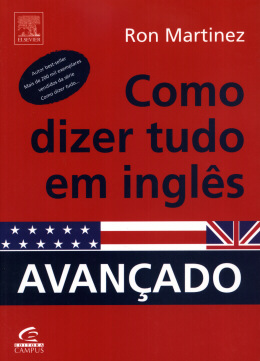Tempo de leitura: menos de 1 minuto
Como Dizer Tudo em Inglês Avançado
Ron Martinez, Elsevier, 2006
Reviewed by Luiz Otávio Barros
Como Dizer Tudo em Inglês Avançado, the latest addition to the Como Dizer Tudo series, is a book I was particularly curious to analyze. While I knew what to expect in terms of approach from the como dizer tudo part of the title, inglês avançado, I must confess, conjured up images of obscure words defined in a dictionary-like fashion and subsumed under a handful of abstract, overlapping categories. After all, as far as vocabulary is concerned, all the advanced student needs is to enlarge his or her repertoire of new and increasingly complex words, right?
 Wrong. Como Dizer Tudo em Inglês Avançado goes beyond that and proves that there’s more to advanced vocabulary than knowing what sounds different animals make or, say, ten different words for rain. Informed by the tenets of Michael Lewis’ Lexical Approach, the book does a great job of helping the advanced learner (CAE / CPE and beyond) get maximum mileage out of what he or she already knows, by presenting “old” words in new, high-frequency combinations. For example, there’s a lesson exploring different uses of thing (no such thing as, the latest thing, not my thing); a comprehensive overview of discourse markers (I mean, I’m afraid, mind you); a lesson tackling advanced verbal meanings of basic nouns (address an issue, foot the expenses, cloud my judgment) and even a closer look at elliptical expressions (go figure, might as well).
Wrong. Como Dizer Tudo em Inglês Avançado goes beyond that and proves that there’s more to advanced vocabulary than knowing what sounds different animals make or, say, ten different words for rain. Informed by the tenets of Michael Lewis’ Lexical Approach, the book does a great job of helping the advanced learner (CAE / CPE and beyond) get maximum mileage out of what he or she already knows, by presenting “old” words in new, high-frequency combinations. For example, there’s a lesson exploring different uses of thing (no such thing as, the latest thing, not my thing); a comprehensive overview of discourse markers (I mean, I’m afraid, mind you); a lesson tackling advanced verbal meanings of basic nouns (address an issue, foot the expenses, cloud my judgment) and even a closer look at elliptical expressions (go figure, might as well).
That doesn’t mean, of course, that the syllabus lies exclusively within the confines of expressions like the ones above. To meet the lexical needs of the advanced learner, Ron Martinez has made the wise decision to devote a fairly substantial part of the book to more complex, self-contained words in the moulds of, say, crush, mash and squash. These, however, are approached in a refreshing, brain-friendly way and categorized on the basis of criteria that few books, to the best of my knowledge, have dared to use. For example, Como Dizer Tudo groups words like jiggle, wriggle and wiggle phonologically, which means that students will be encouraged to learn together words that not only sound similar but also have related meanings (-ggle words, the book tells us, tend to describe small, repeated movements). The author then uses some of these “advanced” words as a springboard for more colloquial, everyday expressions (e.g.: He tried to wriggle his way out of it), in a clear attempt to stay faithful to the original goal of the series.
I was very impressed by the sheer scope and depth of the 10 sections of the book, which contain not only clear, memorable definitions (aided by the judicious use of Portuguese) and real or real-sounding examples, but also challenging exercises with a clear emphasis on chunking and collocation throughout. If you’re an advanced learner or teacher seeking to “sound more native”, Como Dizer Tudo em Inglês Avançado is definitely a must-have. Highly recommended.
The reviewer
Luiz Otávio Barros (MA Hons), teacher, teacher educator and coursebook writer, is the second vice president of BRAZ-TESOL. Email: [email protected]

Eu tenho esse livro e posso dizer que supera as expectativas que alguém pode ter com relação a ele. Sem falar dos exercícios que fazem com que as palavras colem na sua memória. Muitas palavras eu aprendi com o livro como por exemplo o verbo ‘to water’, e nunca mais esqueci que significa ‘regar as plantas’.
This book is already on my purchase list for next month.
Ulisses I can’t wait to see the second issue of “25 micos em inglês”.
See you!